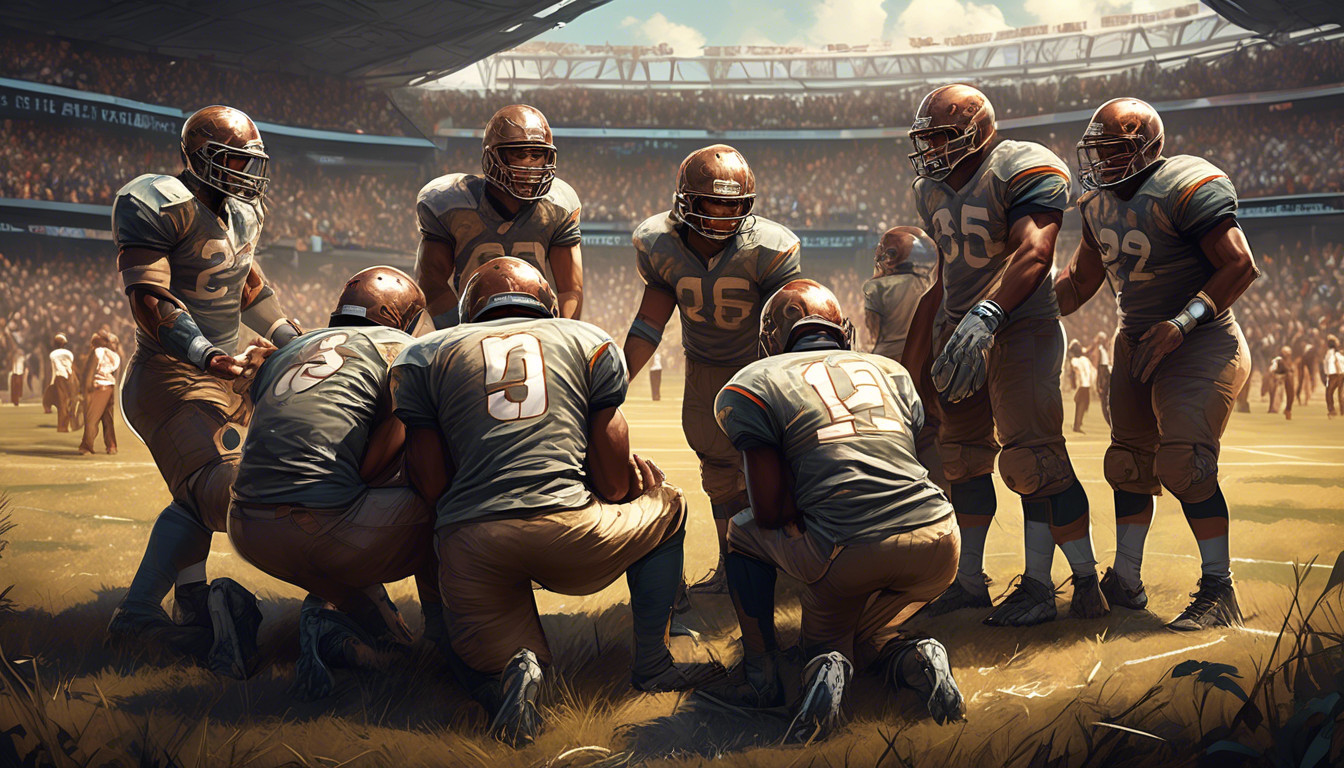As avid hockey enthusiasts, we have witnessed a remarkable transformation in the way we engage with the sport we love, thanks to the rise of sports betting. This shift is not merely a trend but a dynamic change in our relationship with hockey.
Gone are the days when we simply watched our favorite teams battle it out on the ice; now, every goal, assist, and penalty carries a heightened sense of excitement and anticipation. Sports betting has introduced a new layer of interaction, allowing us to participate in the action and elevating our fan experience to unparalleled levels.
We find ourselves more invested in games, analyzing player statistics, and discussing strategies with fellow fans. This engagement is not limited to seasoned bettors; even casual fans are drawn into this realm, making each match an opportunity for:
- Strategic thinking
- Camaraderie
Together, we explore how this burgeoning industry is redefining our hockey experiences.
Evolving Fan Participation
In recent years, fan participation in hockey has evolved dramatically due to the rise of sports betting platforms. These platforms have ushered in a new era of fan engagement, where we’re not just spectators but active participants in the sport we love.
By placing bets, we feel a deeper connection to the game, sharing the highs and lows with fellow fans. This shared experience fosters a sense of belonging, as we unite over common goals and outcomes.
Sports betting has transformed our relationship with hockey, making every match more personal and thrilling. We’re no longer passive viewers; instead, we’re part of a vibrant community that thrives on the excitement of the game.
- The stakes are higher
- Our emotions are more intertwined with each period and play
As we engage with various betting options, we find ourselves more invested in the teams and players, creating a dynamic atmosphere where our passion for hockey is amplified.
Enhanced Game Excitement
With every wager we place, the anticipation and thrill of each hockey game increase exponentially. Sports betting transforms us from passive spectators to active participants, deepening our connection with the game and each other.
As we gather with friends and fellow fans, discussing odds and potential outcomes, we create a shared experience that amplifies our excitement. The thrill isn’t just in watching the puck glide across the ice; it’s in knowing that our predictions and stakes make every play feel personal.
Fan engagement reaches new heights when sports betting enters the arena. We find ourselves more invested in not just our favorite team, but in every game, every period, and every shift. The energy in our living rooms or at the rink becomes electric, as each goal or save directly impacts our wagers.
This shared journey through the highs and lows of the game fosters a sense of community and belonging, uniting us in our shared passion and excitement.
Data Analysis Impact
Leveraging data analysis, we’ve gained unprecedented insights into our betting strategies, allowing us to make more informed decisions. This analytical approach has transformed our sports betting experience, creating a deeper connection with the game.
We now have access to a wealth of statistics and trends, making every match a thrilling opportunity to test our insights and predictions.
As fans, this data-driven engagement enhances our appreciation for the sport, fueling our excitement for each game. We share this journey with fellow fans, discussing data points and odds, which fosters a sense of community and belonging.
The integration of analytics into our betting routines isn’t just about numbers; it’s about connecting with the sport on a whole new level.
With each play dissected and analyzed, our understanding of the game grows, making our involvement more dynamic.
The excitement isn’t just in watching the game; it’s in participating actively through informed sports betting, elevating our overall fan experience.
Community Engagement Boost
Our shared enthusiasm for analyzing game data has sparked lively discussions and strengthened our camaraderie as a community. Sports betting isn’t just about wagers; it’s about engaging deeply with the game and each other. This new dimension of fan engagement unites us, as we exchange insights and predictions, which elevates the game excitement to new heights.
When we gather, whether online or in person, the conversations often revolve around the latest stats and potential outcomes. It’s this shared pursuit of understanding the game that bonds us, creating a vibrant space where every voice contributes to the collective experience. The thrill of sports betting has added layers to our hockey passion, making every match more than just a game.
Together, we’ve built a community where diverse perspectives enhance our understanding and enjoyment. We revel in the shared anticipation and the joy that comes with predicting the unpredictable, making our hockey experience richer and more inclusive.
Betting Strategies Unveiled
Let’s dive into a few key strategies that can enhance our betting success and deepen our understanding of hockey dynamics.
1. Thorough Research
- By staying informed about team performance, player injuries, and recent trades, we boost our sports betting accuracy.
- This knowledge fosters a sense of community and camaraderie among us fans, as we share insights and analyze upcoming games together.
2. The Value of Live Betting
- By engaging with the game in real-time, we can react to shifts in momentum and make informed decisions.
- This adds an extra layer of game excitement, turning each play into a potential opportunity.
3. Managing Our Bankroll
- By setting limits and sticking to them, we ensure our betting remains a fun and engaging part of our hockey experience, rather than a stressor.
Together, these strategies not only enhance fan engagement but also enrich our overall appreciation of the sport we love.
Player Performance Focus
Understanding player performance is crucial as it allows us to identify key players who can significantly impact the outcome of a game. With sports betting becoming an integral part of our hockey experience, we find ourselves diving deeper into player statistics and trends.
We’re not just passive spectators anymore; we’re part of a community that thrives on insights and analysis. This shared interest in player performance enriches fan engagement, making each game more thrilling and meaningful.
When we invest in sports betting, we’re motivated to track how players perform, not just the final score. It adds layers of interest, where every pass, shot, and save becomes a potential game-changer. This focus heightens the excitement of the game, as we anticipate how our predictions will unfold.
The camaraderie that develops from discussing player performances bonds us with fellow fans, creating a sense of belonging and shared enthusiasm. Together, we celebrate the highs and analyze the lows, deepening our connection to the sport.
Fan Interaction Intensified
As we delve deeper into the world of hockey, our interactions with fellow fans become more vibrant and engaging. Sports betting has taken our community by storm, transforming how we connect with the game and each other. We aren’t just passive observers anymore; we’re active participants, eagerly discussing odds, potential outcomes, and game excitement. This shared experience creates a sense of camaraderie and belonging among us, uniting fans under a common goal.
Fan engagement reaches new heights when we:
- Gather to analyze statistics
- Share insights
- Cheer for our bets
Our conversations are filled with anticipation and strategy, making every match more thrilling. We celebrate victories together and console each other in losses, strengthening our bonds.
Through sports betting, the stakes are higher, and so is our investment in the game. We’re more than just spectators; we’re part of a passionate community that thrives on the excitement and unpredictability of hockey. Together, we elevate our fan experience.
Viewing Experience Augmented
With every game, our viewing experience becomes richer and more immersive, drawing us deeper into the world of hockey.
Sports betting has transformed the way we watch, adding layers of excitement and engagement that weren’t there before. We’re not just passive spectators; we’re active participants in the unfolding drama on the ice. The thrill of placing a bet and watching the game unfold with anticipation creates a sense of camaraderie among us fans, uniting us in shared moments of tension and triumph.
As we engage with sports betting, the game’s stakes feel higher, and each play matters more. We find ourselves analyzing every pass, shot, and save with renewed interest, as our predictions and bets hinge on the outcome.
This interactive dimension enhances our connection to the game, making each viewing experience more meaningful. Together, we share in the collective excitement, deepening our bond with the sport and with each other, as we cheer and strategize for victory.
Emotional Investment Heightened
Our emotional stakes rise as we immerse ourselves in the thrill of each game. Sports betting elevates our engagement, transforming us from mere spectators to invested participants.
Heightened Connection:
- As we place our bets, we feel a stronger connection to the players and the action on the ice.
- The excitement of the game intensifies, making each play, goal, or save feel like a personal victory—or defeat.
Shared Experience:
- We find ourselves cheering louder, urging our chosen teams or players to triumph, creating a shared experience with fellow fans.
- This collective anticipation and celebration deepen our sense of belonging within the hockey community.
Adding Complexity and Excitement:
- Sports betting adds layers of complexity and excitement, making the outcomes feel more meaningful and personal.
Engagement and Significance:
- As we gather to watch games, whether at arenas or with friends at home, our bets prompt spirited discussions and predictions.
- This dynamic adds a fresh level of engagement, ensuring that every pass and shot holds significance, enriching our overall experience.
Impact on Team Loyalty
Our betting choices can significantly influence our loyalty to certain teams, reshaping our traditional allegiances. With sports betting becoming more prevalent in hockey, we often find ourselves rooting for teams based on our wagers rather than deep-seated loyalties. This shift creates a unique blend of emotions, where our financial stakes intertwine with our passion for the game. It’s not just about wearing the team colors anymore; it’s about the thrill of every goal and save, making fan engagement more dynamic and personalized.
As we place our bets, the usual boundaries of team loyalty blur, and we become part of a broader community of fans who share in the highs and lows dictated by the scoreboard. Game excitement reaches new heights when betting is involved, as each play can impact our potential wins.
Through sports betting, we forge new connections, finding camaraderie in our shared experiences, and expanding our sense of belonging within the ever-evolving hockey landscape.
Sport Betting Integration
As hockey fans, we’re witnessing the seamless integration of betting platforms into our viewing experience, enhancing the way we interact with the sport. Sports betting has become more than just a side activity; it’s now at the heart of our fan engagement.
By placing wagers, we’re not just spectators—we’re participants, deeply involved in every play and outcome. This level of participation transforms our usual viewing sessions into an exciting, interactive experience.
The thrill of the game increases as we:
- Analyze stats
- Predict outcomes
Every goal and save becomes a pulse-racing moment. With real-time odds and updates, our connection to the game becomes more personal and dynamic.
We feel a new sense of camaraderie with fellow fans, as we share in the highs and lows of our betting adventures. By integrating sports betting, we’re not only enhancing our enjoyment but also creating a more immersive community.
Together, we redefine what it means to be passionate hockey fans.
Future of Fan Engagement
As we look ahead, emerging technologies and innovative platforms are set to revolutionize how we connect with our favorite hockey teams.
The integration of sports betting into our fan experience is more than just placing wagers; it creates a deeper, more personal bond with the game. We find ourselves not just watching but actively participating, making every play and every goal an opportunity for game excitement.
Imagine a future where augmented reality apps bring the rink into our living rooms, allowing us to follow the puck from every angle. These technologies, combined with sports betting, enhance our engagement, making us feel like part of the action.
We can:
- Join online communities
- Share predictions
- Celebrate wins together
This strengthens our sense of belonging.
By embracing these innovations, we’re not just spectators. We become part of a larger community, united by our love for hockey and the thrill of the game, making each moment more exhilarating.












































